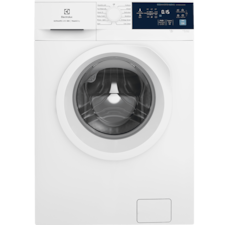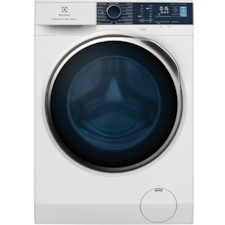A washing machine is a home appliance used to wash laundry. A reliable washing machine is easily one of the most important household appliances you could own. Without a washing machine, doing laundry becomes a much more time-consuming and labor-intensive task.
Once it’s time to buy a new washing machine, the big challenge is to decide whether you go for a front loading or a top loading washer. Both front loading and top loading washers come with their advantages and disadvantages, but which one is better?
Here, Electrolux India will discuss 11 key distinguishing factors between top load vs front load washing machines to help you decide which one fits your needs and style.
Front load washing machines are designed with horizontally mounted inner basket and outer tub. They use a horizontal drum to rotate clothing through water. They often but not always come with transparent side opening door.
With this layout, clothes can be cleaned with minimal agitation without having to be completely submerged in water.
In most regions of the world, high-end washers are often of this type. Most commercial and industrial clothes washing machines worldwide are of the horizontal-axis design as well.
Top load washing machines features a lid on top, meaning clothes are loaded through the top of the machine. They are often but not always covered with a hinged door.
With this layout, you can load your laundry comfortably without having to bend over and most importantly, add or remove laundry mid-cycle.
According to Wikipedia, top load or vertical axis cloth washing machines are dominant design in the United States and Canada.
Choosing the right washing machine can be time-consuming
So, we’ve walked through a brief definition of front loaders and top loaders, but which one is the right choice for you? Should you buy a top-load or a front-load washing machine? The decision mostly comes down to your family’s needs and budget.
To help you make the right choice, take a look at the following list of differences between a top load and front load washing machine:
Obviously, the most outstanding difference between these two types of washing machines is the location of the door. For top-load washers, you put in the laundry from the top, whereas front loaders are opened from the front of the machine.
Front-load washing machines consume less water than top loaders thanks to their design. The reason is that during the wash cycle, front loaders are only partially filled with water, just enough to fully cover the clothes.
To be more specific, they use one-third the amount of water that top loaders use. However, top loaders consume less electricity since the washing time is shorter.
>>> Related reading: How to save electricity when using a washing machine
In term of washing capacity, front-load machines outperform top loaders, since this type of washing machine does not have an agitator, which is a part of top loaders. This leaves more space for clothes, which means you need to do laundry much less often with front loaders.
Generally speaking, front-load washers tend to be better at removing stains than their top-load counterparts. The reason is that a front loader’s tumbling washing motions are more effective than a top loaders’ twisting wash motions.
With top-load washers, clothing tends to clump together during circular wash motions, making it ineffective when washing larger items such as winter coats and pillows.
Read our How to remove paint stains from clothes for proper fabric cleaning process.
If you want to get your laundry done fast, front loaders are not the best option. That’s because front-load washing machines have more complex wash cycles, with a barrel that spins the clothes around and water entering and draining out of the drum during the cycle.
Top loaders have a shorter cycle time since they are filled with water just once during the wash.
Front-load machines have a higher spin speed, around 1500 RPM (revolutions per minute), so they can extract more water from the clothes and save time online drying. In contrast, top-load machines produce only around 600 RPM.
Front loaders are quieter and cause less vibration when washing.
Read more:
Top-load washers are narrower, meaning that you can place the machine in smaller space.
Top-load washers are more convenient since you can freely add or remove clothes to and from the washer. Moreover, if you have back or knee problems, you will find it more difficult to unload your clothes from a front loader.
In addition, kids may get inside your front-load washer since the door is lower.
You will commonly find top loaders cheaper than front loaders.
Comparing a top load vs front load washing machine may not reveal which type is best. Our comparison table below will summarize both pros and cons of these two types and how each model can make your laundry day easier.
Choosing the right washing machine can be time-consuming. Electrolux is well-known for our high-quality and durable washing machines which were designed to fit in your budget without compromising the cleaning performance.
To streamline your search for the best washers, check out our Electrolux washing machines and washer dryer combo.
Check out our Electrolux washing machine reviews with real-life testimonials to choose the right laundry machine for your home!
Once it’s time to buy a new washing machine, the big challenge is to decide whether you go for a front loading or a top loading washer. Both front loading and top loading washers come with their advantages and disadvantages, but which one is better?
Here, Electrolux India will discuss 11 key distinguishing factors between top load vs front load washing machines to help you decide which one fits your needs and style.
What are front load and top load washing machines?
Front load washing machines
Front load washing machines are designed with horizontally mounted inner basket and outer tub. They use a horizontal drum to rotate clothing through water. They often but not always come with transparent side opening door.
With this layout, clothes can be cleaned with minimal agitation without having to be completely submerged in water.
In most regions of the world, high-end washers are often of this type. Most commercial and industrial clothes washing machines worldwide are of the horizontal-axis design as well.
Top load washing machines
Top load washing machines features a lid on top, meaning clothes are loaded through the top of the machine. They are often but not always covered with a hinged door.
With this layout, you can load your laundry comfortably without having to bend over and most importantly, add or remove laundry mid-cycle.
According to Wikipedia, top load or vertical axis cloth washing machines are dominant design in the United States and Canada.
10 main differences between top load vs front load washing machines

Choosing the right washing machine can be time-consuming
So, we’ve walked through a brief definition of front loaders and top loaders, but which one is the right choice for you? Should you buy a top-load or a front-load washing machine? The decision mostly comes down to your family’s needs and budget.
To help you make the right choice, take a look at the following list of differences between a top load and front load washing machine:
1. Design
Obviously, the most outstanding difference between these two types of washing machines is the location of the door. For top-load washers, you put in the laundry from the top, whereas front loaders are opened from the front of the machine.
2. Water & power consumption
Front-load washing machines consume less water than top loaders thanks to their design. The reason is that during the wash cycle, front loaders are only partially filled with water, just enough to fully cover the clothes.
To be more specific, they use one-third the amount of water that top loaders use. However, top loaders consume less electricity since the washing time is shorter.
>>> Related reading: How to save electricity when using a washing machine
3. Capacity
In term of washing capacity, front-load machines outperform top loaders, since this type of washing machine does not have an agitator, which is a part of top loaders. This leaves more space for clothes, which means you need to do laundry much less often with front loaders.
4. Cleaning performance
Generally speaking, front-load washers tend to be better at removing stains than their top-load counterparts. The reason is that a front loader’s tumbling washing motions are more effective than a top loaders’ twisting wash motions.
With top-load washers, clothing tends to clump together during circular wash motions, making it ineffective when washing larger items such as winter coats and pillows.
Read our How to remove paint stains from clothes for proper fabric cleaning process.
5. Cycle time
If you want to get your laundry done fast, front loaders are not the best option. That’s because front-load washing machines have more complex wash cycles, with a barrel that spins the clothes around and water entering and draining out of the drum during the cycle.
Top loaders have a shorter cycle time since they are filled with water just once during the wash.

6. Spin speed
Front-load machines have a higher spin speed, around 1500 RPM (revolutions per minute), so they can extract more water from the clothes and save time online drying. In contrast, top-load machines produce only around 600 RPM.
7. Noise
Front loaders are quieter and cause less vibration when washing.
Read more:
8. Space consumption
Top-load washers are narrower, meaning that you can place the machine in smaller space.
9. Convenience
Top-load washers are more convenient since you can freely add or remove clothes to and from the washer. Moreover, if you have back or knee problems, you will find it more difficult to unload your clothes from a front loader.
In addition, kids may get inside your front-load washer since the door is lower.
10. Price
You will commonly find top loaders cheaper than front loaders.
Top load vs front load washing machine comparison table
Comparing a top load vs front load washing machine may not reveal which type is best. Our comparison table below will summarize both pros and cons of these two types and how each model can make your laundry day easier.
| Front loaders | Top loaders | |
| Pros | Higher spin speed, so your clothes will dry more quickly Cleaner clothes and less damage to fabric Consume less water Have more features Less noise during spin cycle |
Smaller size, suitable for smaller spaces Lower price Consume less electricity Easy to use Safer for families with kids Can be used with most detergents |
| Cons | More expensive Consume more electricity Can only use some specific detergents |
Damage clothes more Consume more water Do not have as many features Make more noise and vibrate more |
Our Top Picks
Choosing the right washing machine can be time-consuming. Electrolux is well-known for our high-quality and durable washing machines which were designed to fit in your budget without compromising the cleaning performance.
To streamline your search for the best washers, check out our Electrolux washing machines and washer dryer combo.
Check out our Electrolux washing machine reviews with real-life testimonials to choose the right laundry machine for your home!
- HygienicCare removes 99.9% allergens and germs*.
- EcoInverter motor uses 50% less energy*.
- Set quick cycles to suit your schedule.
- HygienicCare removes 99.9% allergens and germs*.
- EcoInverter motor uses 50% less energy*.
- Set quick cycles to suit your schedule.
- No more visible detergent residue with UltraMix*.
- HygienicCare removes 99.9% allergens and germs*.
- EcoInverter motor uses 50% less energy*.






